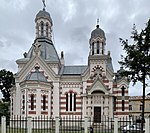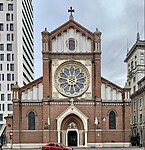The George Enescu Festival (also known as George Enescu International Festival and Competition), held in honor of the celebrated Romanian composer George Enescu, is the biggest classical music festival and classical international competition held in Romania and one of the biggest in Eastern Europe. Enescu's close associate George Georgescu organized the first festival in 1958; highlights included a performance of Bach's Concerto for Two Violins with Yehudi Menuhin and David Oistrakh as soloists and a staging of Enescu's sole opera, Œdipe, with Constantin Silvestri conducting.The official opening day of the Enescu Festival took place on 4 September 1958, merely three years after George Enescu's death. Among the music world's personalities that were present for this first edition of the festival were performers such as David Oistrakh, Halina Czerny-Stefanka, Nadia Boulanger, Monique Haas, Iacov Zak and Claudio Arrau, and conductors such as Sir John Barbirolli, Carlo Felice Cillario and Carlo Zecchi. On 22 September of the same year, the national premiere of George Enescu's lyrical tragedy "Oedipe" took place, starring a young David Ohanesian in the lead role. This role was going to mark out the rest of his career as a soloist (conductor: Constantin Silvestri, Directed by Jean Ranzescu, Scenery: Roland Laub).
Violinist, teacher, conductor and composer, worldwide known for his lush opera composition Oedipe, George Enescu presented his first work as a composer with the Collonne Orchestra in Paris, 1898; he also performed as a conductor at prestigious Carnegie Hall (NY). Enescu was also the teacher of one of the greatest violinists of the past century – Lord Yehudi Menuhin. Their bond was so strong that in 1995, Menuhin accepted the invitation to come to Romania to open the George Enescu International Festival. Menuhin also accepted to be the President of Honor of the Enescu Festival in 1998, though his schedule as a soloist was full up to 2003.
Today, an average of around 20 works by Romanian composer George Enescu are interpreted in the Enescu Festival each edition. The 2015 edition of the Enescu Festival (30 August – 20 September 2015 Bucharest) brings on stage interpretations from Enescu's works by record-breaking German violinist David Garrett, San Francisco Symphony Orchestra (Pulitzer Prize for Music), or Israel Philharmonic Orchestra under Zubin Mehta. Highlights of this edition of the Festival also include violinist Anne-Sophie Mutter, Berliner Philharmoniker, London Symphony Orchestra and Royal Liverpool Symphony Orchestra.
The concerts are held in three different venues in Bucharest, Iași and Sibiu. The 2007 presentations ended with a performance of Carl Orff's Carmina Burana before an audience of over 4,000 at the Sala Palatului.
The competition portion of the Festival lasts about a week, and it consists of three different categories: composition (118 participants in 2007), piano (44 in 2007), and violin (41 in 2007), each a record number of participants.
In the 2005 and 2007 presentations a daily open-air concert was added to the festival program. It is known as the Festival Piazza and features 3½ hours of classical music, in addition to movies about the life of George Enescu.











